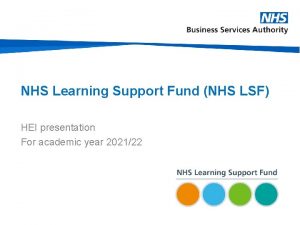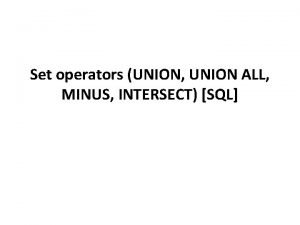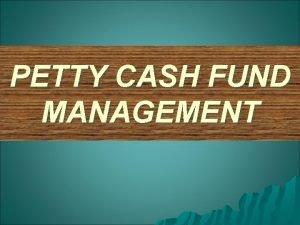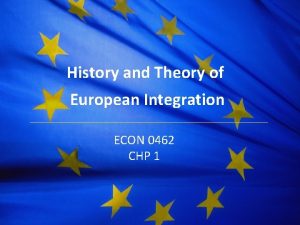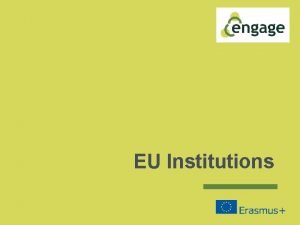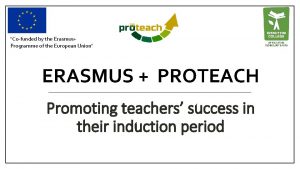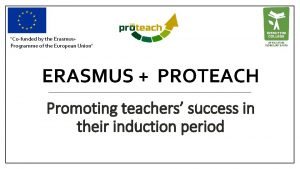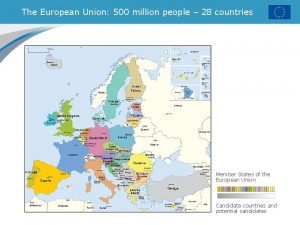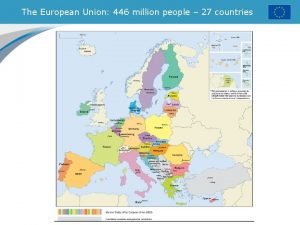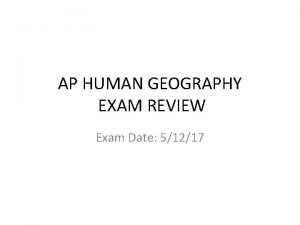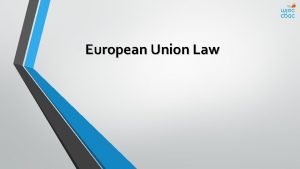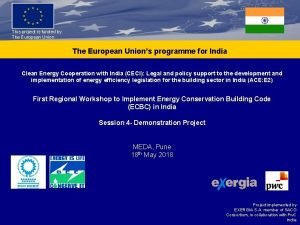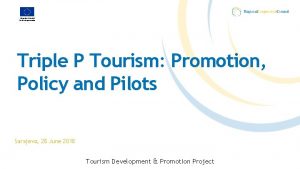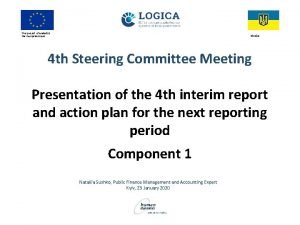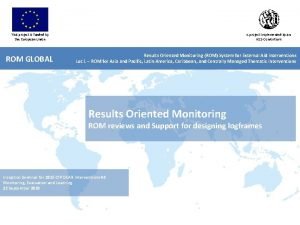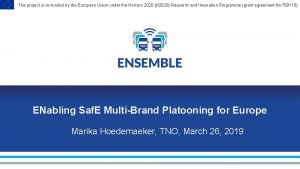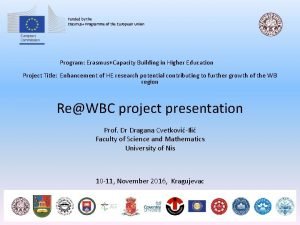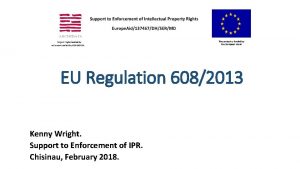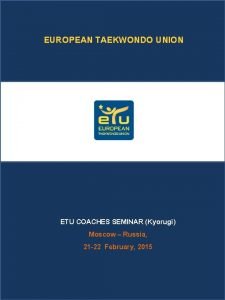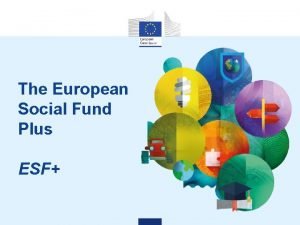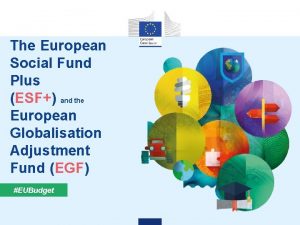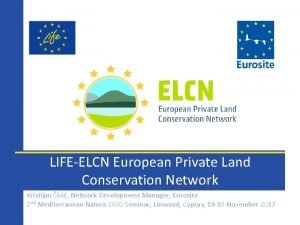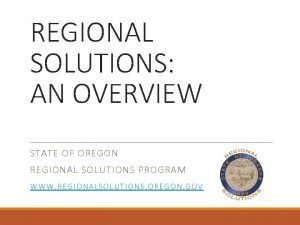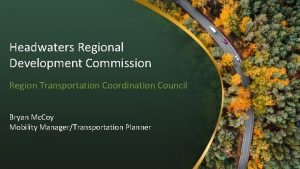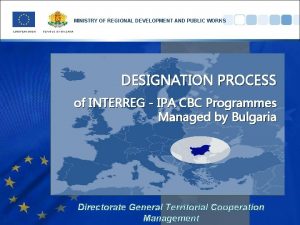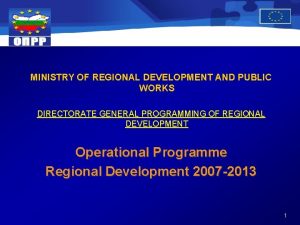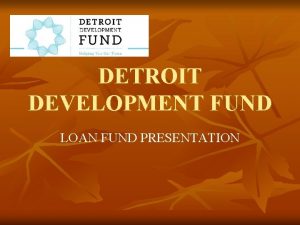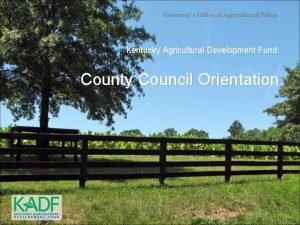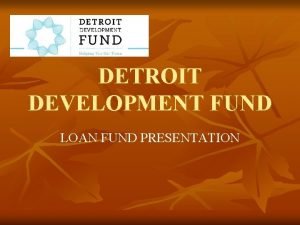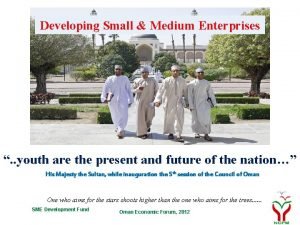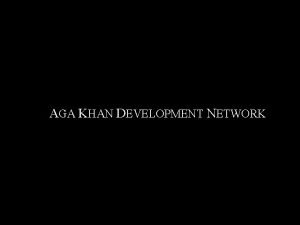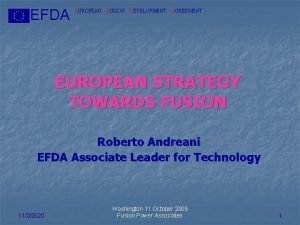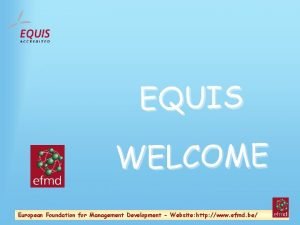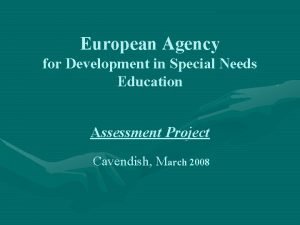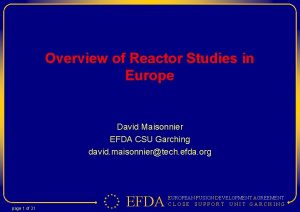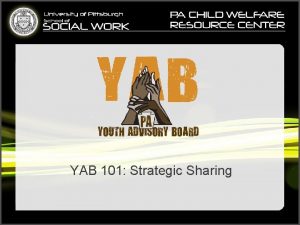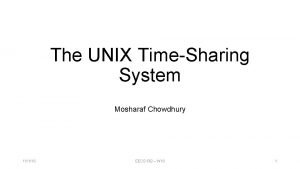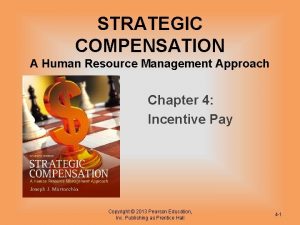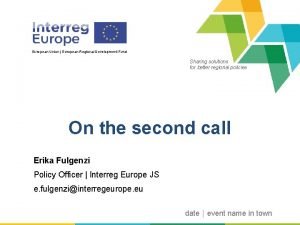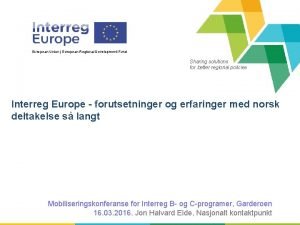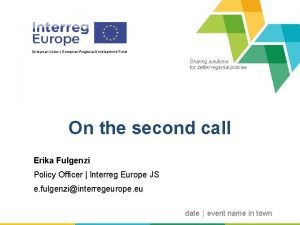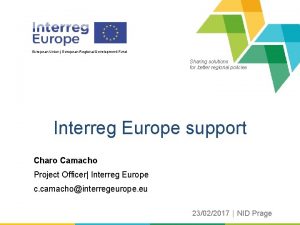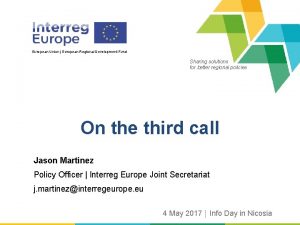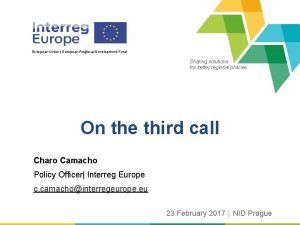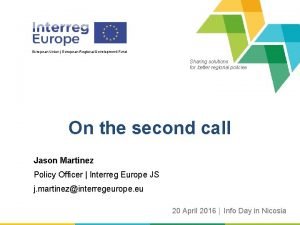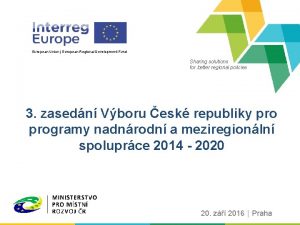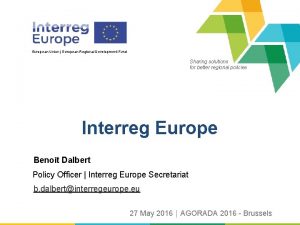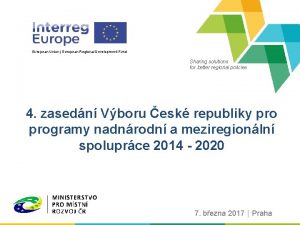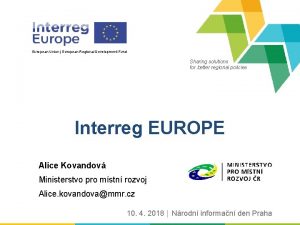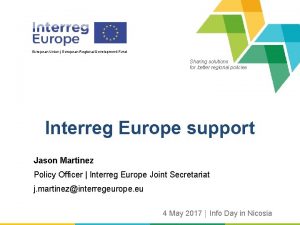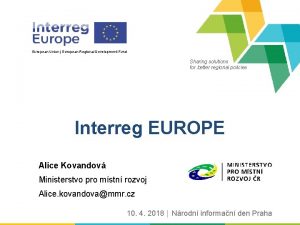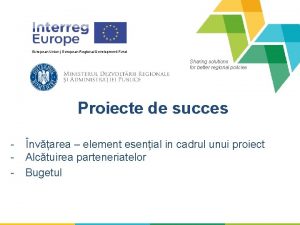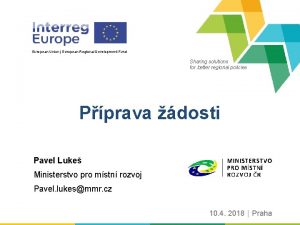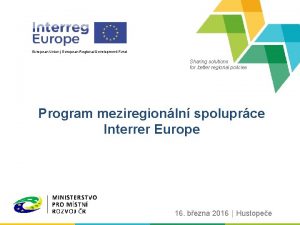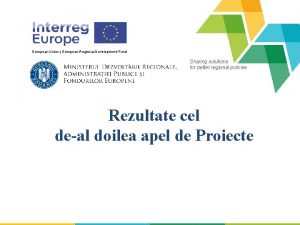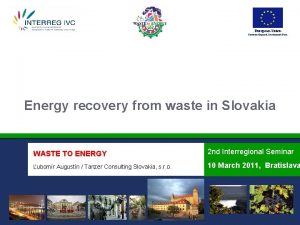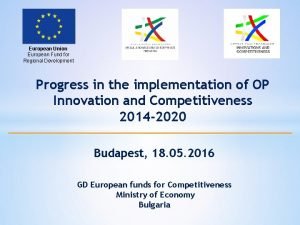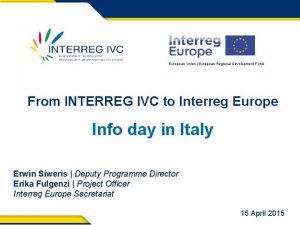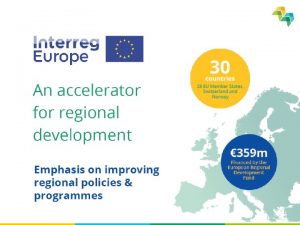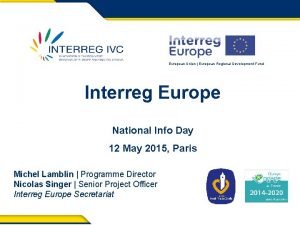European Union European Regional Development Fund Sharing solutions














































- Slides: 46

European Union | European Regional Development Fund Sharing solutions for better regional policies On the second call Jason Martinez Policy Officer | Interreg Europe JS j. martinez@interregeurope. eu 20 April 2016 Info Day in Nicosia

Summary § Lessons learnt from the first call § Few points about application § About assessment 2

LESSONS LEARNT 3

Eligibility 7 eligibility criteria All to be fulfilled to be eligible! Number of failed criteria Number of projects 1 criterion 2 criteria 3 criteria 4 criteria 63 14 8 1 4

Eligibility § High rate of ineligibility (33%) § Main cause of ineligibility: letters of support and partner declaration (missing or incorrect) Make sure all documents are provided and correct. Don’t prepare them at the last minute. 5

Ineligibility criteria per country Not in the list (72) Letter of support missing (48) Letter of support incorrect (30) Partner declaration incorrect (48) Application problem (18) 6

Eligibility Lessons learnt integrated in 2 nd call application pack: 1/ Improved instructions in the application pack: § Reformulation of the criteria and their meaning § Warning messages included in different documents 2/ Full online application § Compulsory documents to be uploaded on i. OLF § Project summary no longer necessary 7

Quality: common weaknesses Criterion 1: Topic addressed § Needs to be clearly in line with priority axes § Needs to be focused and as specific as possible § Needs to be reflected in all policy instruments addressed 8

Quality: common weaknesses Criterion 1: Policy instruments § Needs to be precisely defined (e. g. indication of the specific priority addressed) § For Structural Funds: the instrument addressed needs to be the Operational / Cooperation programme itself 9

Quality: common weaknesses Criterion 3: Policy relevance of partners § Policy relevance = involvement of an organisation in the policy making process and capacity to influence to policy instrument § Core elements of the quality of partnership (dedicated questions in section B. 2 of the application form) § Letter of support is not sufficient to demonstrate policy relevance of a partner 10

Quality: common weaknesses Criterion 3: Geographical features § Coverage: going beyond transnational area 11

Quality: clarification Criterion 3: mixing more and less developed regions (GDP) § Mix more and less developed regions (GDP) 12

Quality: common weaknesses Criterion 3: multiple involvement § Involvement in numerous applications is demanding and is not recommended § Be strategic: select only the most relevant project(s) for your region § Justify in case you are involved in several applications (section B. 2 of the application form) 13

Quality assessment: conclusion Importance of the application form Fairness and equal treatment principles: § Application Form = the only basis for assessment § same information requested from all § same technical requirements for all (e. g. text limits) § Application form has to be self-explanatory Additional information / clarification not possible after submission 14

ON APPLICATION 15

Recommendations for applicants § Read the programme manual and check assessment criteria § Start from your need § Be specific, make sure the topic addressed is focused and reflected in the policy instruments § Take the learning process seriously § First activities, then budget planning § Communication serves your project 16

In the application form Policy instruments 17

Ho. Care Operational Program "Competitiveness and Sustainable Development" 2014 -2020 Objective: “Promotion of holistic, integrated, complex and multiparameter solutions that will enhance the competitiveness of the priority sectors”. “Expansion of the ability of the RTDI system to produce results of high standards and utilize them for the benefit of the competitiveness of the economy and social advancement/progress” “Development of substantial/valid links and synergies between the elements of the guardable helix” In sectors: “Health: ehealth… In addition, the Environment and the ICT were defined as important sectors of horizontal character” and “ICT: ICT Application, Future Technologies” Priority or Measure Concerned: Priority Axis 2: “Fostering the use of ICT” Priority Investment 2 c: “Enhancing ICT applications for e-government, e-learning, einclusion, e-culture and e-health”. 18

CHRISTA Pafos Regional Strategic Tourism Development Plan As part of the repositioning strategy of Cyprus, Pafos had decided to prepare their own vision for tourism development and to create a separate product (regional brand) utilizing and investing in the available merits. This resulted in the 'Pafos Regional Strategic Tourism Development Plan' launched in 2008 with a 5 year implementation horizon initially. The Strategy places particular emphasis on cultural & heritage tourism. Cultural Tourism ranks as first priority category, considered one of the fast growing segments of the global tourism industry, with huge benefits. Cultural Tourism is associated with current expectations of travellers on learning a different way of life and understanding of another culture, is among the special forms of tourism which are designed to target specific segments and is considered as a product with high growth prospects. There is great need of updating and upgrading this policy instrument, in the light of the rapidly changing tourism demand developments in the cultural status of Pafos, such as the selection of Pafos to be the 2017 European Capital of Culture. The Strategic Plan must have a new target year of 2020 and beyond. A key purpose of the upgraded and enhanced policy instrument is the preparation of Action Plans. There is scope of interfacing with the 'Operational Programme Competitiveness & Sustainable Development'; the improved policy instrument can form the basis for mainstreaming into European Structural and Investment Funds. 19

In the application form Territorial context 20

Ho. Care : Operational Program "Competitiveness and Sustainable Development" 2014 -2020 In Cyprus, home care is currently provided by Municipalities and Community Councils on local level (these are the two levels of local authorities in Cyprus). According to the Law, Municipalities have the right for provision of social services (in general, including social/health care) through the establishment of local social foundations and the establishment of local programs for supporting the target groups according to their needs. Home care is provided to people in need (mostly elders). All such programs run by the local authorities are evaluated, controlled and partially funded (after approval) by the central government through financing schemes provided by the Social Welfare Services. In the last years, due to the bad situation of the economy (financial crisis – Cyprus is currently under an MOU for support through the financial mechanism of European Central Bank, the IMF and the European Commission) financing for these type of activities has been reduced and minimized by the central government, therefore, most Municipalities are facing huge economic problems on maintaining local social care services (including home care) totally through their own budget. As a result there a lot of local social/health foundations that have already stopped their activities, in opposition to the continuously rising need for such services. Preventive measures and new ways of managing and implementing home care services are currently very highly needed, especially if their application would result to the reduction of the budget required for covering the needs for general local social care activities and services. Therefore, the generation of innovative Home Care solutions (i. e. ehealth) in regional innovation chains (that would also reduce the cost of these services) is a need and is an issue which has to be tackled by smart policy instruments, in particular by Structural Funds. 21

CHRISTA : Pafos Regional Strategic Tourism Development Plan Pafos is a diverse province with developed tourist waterfront, urban areas, with inland plains, hilly and mountainous areas includes a large number of municipalities. It has rich history and tradition, archaeological sites, cultural and religious monuments. Particularly archaeology and mythology of the area and its connection with the goddess of love Aphrodite, is notable. It has a rich flora and fauna with various endemic species while the region is the Akamas National Forest Park. Pafos is a remarkable milestone for tourists with special interest in culture. It has museums, cultural monuments, archaeological sites, churches, traditional products, cultural events, traditional cuisine, etc. , the coexistence of which gives it a unique beauty. The cultural value of Paphos further strengthened by existing myths that surround the area, In addition to the existing cultural infrastructure of the province including theaters, and other places that host modern cultural activities (arts, visual arts, music, etc. ). Pafos has been selected to be the European Capital of Culture (ECo. C) for 2017. This experience will be shared with the project partners and the activities of Pafos 2017 ECo. C will support the project and the legacy will be further exploited in the project activities. Pafos as ECo. C suggests making the best of its openair sites by turning them into an Open. Air Factory of Culture. With its archeological sites, its squares, its streets, its other artistic events, it can bring the cultural activities of the city closer to the visitors. “Linking Continents, Bridging Cultures” is the dynamic “motto” main characteristic of Pafos 2017. Inspired by its geographical position, since it has always been the crossroad of Eastern Mediterranean, and by its modern multicultural reality, Pafos aspires to become the first ECo. C which will link the East and the West, bridge people and cultures, and it will also be a place of cultural collaboration and peaceful coexistence. 22

What is learning process? Learning process = interregional exchange of experience building on experiences and practices Based on: identification, analysis & transfer of knowledge and practices How: through a well-thought process supported by seminars, study trips, workshops, staff exchanges, peer reviews, etc. 23

Why is it so important? Cornerstone of an interregional cooperation project Catalyst for generating policy change in the involved regions Territorial need Results 24

How to organise it? PHASE 1 PHASE 2 Learning Acting 25

How to organise it? No magic recipe but a few important ingredients: A. Ensure learning at different levels B. Ensure the quality of each learning activity C. Ensure an integrated approach 26

A. Multidimensional aspect of learning 3. Regional stakeholders learning 2. Organisational learning 4. External / EU level learning 1. Individual learning Go beyond individual / organisational learning! 27

A. Multidimensional aspect of learning Policy making is complex: § usually an organisation cannot change a policy alone Stakeholder group: § increase the chance of policy change Necessity to involve relevant stakeholders in the learning process (travel and accommodation costs eligible if paid by a partner) 28

B. Quality of activities For all learning activities, importance of: § Preparation - Before § Implementation - During § Follow-up (documentation and monitoring) - After 29

C. Integrated approach § How to ensure the overall coherence of the learning process? § What are the main steps to reach the objectives and ensure the quality of action plans? § What are the activities needed and in which order? Can be more or less complex but 30

C. Integrated approach No ‘one-size-fits-all’ Different parameters influencing the process: § History of the partnership § Number of partners § Duration of phase 1 § Topic addressed § …. 31

C. Integrated approach No ‘one-size-fits-all’ but 3 steps commonly adopted: Step 1 Analysis of partners’ situations with local stakeholders and identification of valuable experience and practices Step 2 Review of identified practices supported by interregional exchange of experience activities (e. g. study visits, thematic workshops) with view to transfer Step 3 Further investigation of good practices with local stakeholders and finalisation of action plans backed up with further interregional/ bilateral events 32

Ingredients in the application form Overview in section C. 4 33

In the application form Detailed description of activities in D. 1 34

In the application form C 4: objectives, target groups and activities D 1: Workplan per semester 35

ON ASSESSMENT 36

Selection procedure 2 -step procedure § I. eligibility assessment fulfilment of technical requirements § II. quality assessment 2 step qualitative evaluation Detailed description in the programme manual (§ 5. 3): 37

Eligibility principles § Technical yes or no process § No correction possible § Only eligible applications are further assessed 38

Is your answer ‘yes’? § Is your application complete (application summary, partner declarations, support letters)? § Is the application filled in according to instructions? § Is it in English? § Are all partner declarations: § Signed and dated § With name of partner identical to application form § With stated amount covering at least the amount of partner contribution § With no amendments to the standard text 39

Is your answer ‘yes’? § Are all support letters: § Attached to the application form § Signed and dated by relevant organisation (check the country-specific list!!) § With name of partner(s) identical to application form § With no amendments to the standard text § Are at least 3 countries of which 2 are EU members involved and financed by Interreg Europe? § Is half of the policy instruments related to Structural Funds? 40

Quality assessment 2 nd step for eligible applications 2 -step approach 1. strategic assessment 2. operational assessment Scoring system (0 -5) Decision by monitoring committee 41

Strategic assessment Criterion 1: Relevance of proposal Criterion 2: Quality of results Criterion 3: Quality of partnership Only projects reaching at least an adequate level (≥ 3. 00) are further assessed for operational criteria. 42

Operational assessment Criterion 4: Coherence of proposal & quality of approach Criterion 5: Quality of management Criterion 6: Budget and finance Only projects reaching at least an overall adequate level (≥ 3. 00) are recommended for approval (with conditions) to the monitoring committee. 43

Assessment provisional timing May - June 2016 Eligibility check June – October 2016 Quality assessment End 2016 Decision & notification Early 2017 Negotiation of conditions Early 2017 Effective start date of projects 44

Useful links Programme manual § www. interregeurope. eu/help/programme-manual/ Application pack § www. interregeurope. eu/projects/apply-for-funding/ Online application/ reporting system § www. iolf. eu/ Interreg Europe community § www. interregeurope. eu/account/dashboard/ 45

European Union | European Regional Development Fund Sharing solutions for better regional policies Thank you! Interregeurope
 Nhs learning support fund
Nhs learning support fund Intersect and minus in sql
Intersect and minus in sql Imprest fund system adalah
Imprest fund system adalah European union history
European union history European union institutions explained
European union institutions explained Co-funded by the erasmus+ programme of the european union
Co-funded by the erasmus+ programme of the european union Co-funded by the erasmus+ programme of the european union
Co-funded by the erasmus+ programme of the european union European union 28 countries
European union 28 countries European union 28 countries
European union 28 countries European union military
European union military Hinterland ap human geography
Hinterland ap human geography Https://europa.eu/european-union/index_en
Https://europa.eu/european-union/index_en This project is funded by the european union
This project is funded by the european union This project is funded by the european union
This project is funded by the european union This project is funded by the european union
This project is funded by the european union This project is funded by the european union
This project is funded by the european union This project is funded by the european union
This project is funded by the european union This project is co-funded by the european union
This project is co-funded by the european union Co-funded by the erasmus+ programme of the european union
Co-funded by the erasmus+ programme of the european union This project is funded by the european union
This project is funded by the european union Etu taekwondo
Etu taekwondo Eureka european commission
Eureka european commission European social fund plus
European social fund plus European social fund plus
European social fund plus Www.elcn
Www.elcn Oregon regional solutions
Oregon regional solutions Headwaters regional development commission
Headwaters regional development commission Ministry of regional development and public works
Ministry of regional development and public works Ministry of regional development and public works
Ministry of regional development and public works Entrepreneurship and regional development
Entrepreneurship and regional development Detroit development fund
Detroit development fund Kentucky agricultural development fund
Kentucky agricultural development fund Detroit development fund
Detroit development fund Sme development fund oman
Sme development fund oman Fastoplast
Fastoplast European fusion development agreement
European fusion development agreement European foundation for management development
European foundation for management development European agency for development in special needs education
European agency for development in special needs education European fusion development agreement
European fusion development agreement European fusion development agreement
European fusion development agreement Office solutions development
Office solutions development Strategic sharing
Strategic sharing Unix timesharing system
Unix timesharing system Golden rules for information sharing
Golden rules for information sharing Scanlon plan
Scanlon plan Sharing is caring
Sharing is caring Load sharing anchor
Load sharing anchor
